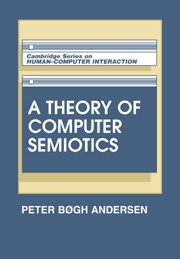 A Theory of Computer Semiotics
A Theory of Computer Semiotics II.2 - Composite computer-based signs
Published online by Cambridge University Press: 26 March 2010
Summary
In the previous part, I described the basic properties of computer-based signs. They have three main kinds of features (permanent, transient and handling features) and are organized in two main chains (concurrent and sequential). In this part, I shall treat composite computer-based signs. How are smaller computer-based signs combined to form larger signs?
It is very clear that complex signs corresponding to linguistic concepts like phrases, sentences, and periods exist. The player of video games will experience long nerve-racking combat episodes involving the hero and one or more enemies, and the user of a word processor will engage in major tasks like proof-reading a manuscript or reorganizing the composition of a text, involving extensive handling of tools and text. Since these larger activities are manifested in system processes, they must be considered signs also, and since they contain smaller recurrent elements with meaning (the hero and enemy, the tools and texts), they are composite signs.
Although the three main features of computer-based signs have been treated in detail, I have not yet said much of the analytical consequences of the fact that computer-based signs participate in two different chains.
I shall continue using the textbook on folk-dance from Section II. 1.2, since a dance instructor or a writer of textbooks on dance faces problems similar to those facing a designer of computer systems. Like the designer prescribing the sequence of computer-based actions and the stage of the screen, the dance instructor must teach the dancers how to move in time on the floor, how to coordinate their movements with their partner, how to hold each other, and how to establish collective patterns.
- Type
- Chapter
- Information
- A Theory of Computer SemioticsSemiotic Approaches to Construction and Assessment of Computer Systems, pp. 267 - 330Publisher: Cambridge University PressPrint publication year: 1991


